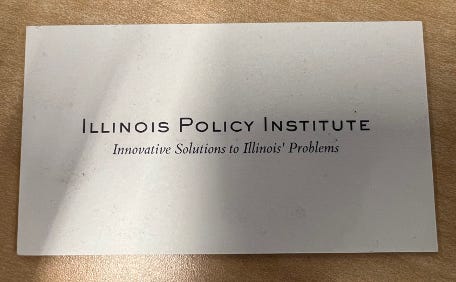Rubber tanks, corkscrews and Winston Churchill
I like to think if I ever had dinner with Winston Churchill, he’d say: “Illinois Policy Institute has corkscrew thinking for Illinois’ problems”
The back of my business card says something Winston Churchill would have taken issue with. It says: “Illinois Policy Institute: Innovative solutions to Illinois’ problems.”
Churchill wouldn’t have used the word “innovative.” He would have called it “corkscrew thinking.”
He developed that term because for most of World War II the outlook was dark for England. In every measure of military superiority, Germany had the advantage.
Germany initially had better planes. They had more soldiers, and those soldiers were better trained. They had more and better tanks, guns and U-boats.
He knew the war would not be won if England used traditional methods to face the Germans.
But Churchill realized he had an unfair advantage: He called it “corkscrew thinkers.”
Corkscrew thinkers are people who think differently: Individuals who see the world as it could be, not as it is. People who look at a problem and see an opportunity.
Churchill created a special division to house his corkscrew thinkers, the “XX committee.”
The corkscrew thinkers created the Sten gun – a machine gun that was produced at one-fiftieth the cost of a normal gun and was produced by a bicycle manufacturer.
They deployed a “ghost army” of inflatable tanks and rubber airplanes. It confused the Germans about the intended attack point of D-Day.
They considered turning icebergs into mid-Atlantic airfields and dropping Hilter look-alikes in Greece to order German troops to surrender.
In other words, Churchill deployed innovative solutions to England’s problems.
The result was that Churchill was able to compete with a fraction of the resources.
Today, we use Churchill's “corkscrew thinkers” in Illinois.
If we are going to compete, we need to use our unfair advantages of creativity and innovation.
While unions are outspending us 6-1 in the Amendment 1 battle, we’ve got outsized impact by securing editorial opposition, including The Wall Street Journal, Chicago Tribune, Daily Herald, News-Gazette and Crain’s Chicago Business. We directly target our campaign to persuade the people who will influence the election results the most, with sniper-like focus.
As public school reading and math scores are rapidly failing, we’re producing a documentary showing the failure of the Chicago Teachers Union – including securing the website ChicagoTeachersUnion.com – and helping thousands of people get freedom by opting out of their unions in record numbers.
For the past 20 years, less than half of Illinois residents had a candidate to vote for to represent them in Springfield because there was only one candidate running. So we recruited free-market candidates in 89% of the districts statewide – the highest number recorded. That work will increase voter turnout by over 200,000 votes.
We’ve hired a cartoonist, created econometric studies to determine the most effective lawmakers to partner with to pass bills and created Mike Madigan mascot heads (well, the merit of some ideas might be debatable).
But it’s these innovative ideas that give us an unfair advantage.
That’s why I like to think if I ever had dinner with Winston Churchill, he’d say: “Illinois Policy Institute has corkscrew thinking for Illinois’ problems.”




